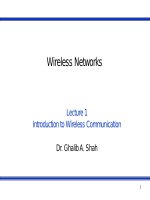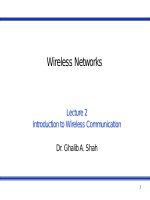Wireless networks - Lecture 18: GPRS: General packet radio service (Part 2)
Bạn đang xem bản rút gọn của tài liệu. Xem và tải ngay bản đầy đủ của tài liệu tại đây (357.97 KB, 27 trang )
Wireless Networks
Lecture 18
GPRS: General Packet Radio Service (Part II)
Dr. Ghalib A. Shah
1
Outlines
GPRS Protocol Architecture
►
►
►
►
MS – BSS
BSS – SGSN
SGSN – GGSN
GGSN – PDN
GPRS Air Interface
Data Routing and Mobility
Uplink Data Transfer
Downlink Data Transfer
QoS in GPRS
2
Last Lecture
Introduction to GPRS
GPRS Architecture
Registration and Session Management
Routing Scenario in GPRS
Channels Classification
3
Logical Channels
Mapped by the MAC to physical channels
Control channels for control, synchronization
and signaling
• Common
• Broadcast
• Dedicated
Packet Traffic channels
► Encoded speech
► Encoded data
4
Control Channels
Packet Common Control Channel (PCCCH)
► When allocated in a cell, GPRS related mobiles
camp on it
► Divded into
• Random Access (PRACH): MS initiate packet transfer or
respond to paging messages
• Paging (PPCH): to page an MS prior to packet transfer
• Access Grant (PAGCH): send resource assignment to MS
prior to packet transfer
• Packet Notification (PNCH): used to send a PTM-Multicast
notification to group of MS
5
Control Channels
Packet Dedicated Control Channel (PDCCH)
• Slow Associated Control Channel (SACCH)
–
–
Radio measurements, power control and data
SMS transfer during calls
• Fast Associated Control Channel (FACCH)
–
–
For one Traffic Channel (TCH)
Carry Ack
• Stand-alone Dedicated Control Channel (SDCCH)
–
is used in the GSM system to provide a reliable connection for
signalling and Short Message Service.
6
Control Channels
Packet Broadcast Control Channel (PBCCH)
► Frequency correction channels
• Allows the MS to synchronize their Local Oscillator (LO) to
the Base Station LO, using frequency offset estimation and
correction.
► Synchronization channel (MS freq. vs. BS)
► Broadcast control channel for general information on
the base station
7
GPRS Architecture
Other GPRS
PLMN
GGSN
Gp
BSC Gb
SGSN
Gf
Gs
BTS
MS
Gn
BTS
EIR
Gr
D
Gc GGSN Gi
HLR
MSC/VLR
8
PDN
Protocol Architecture
Trans mis s io n Plane
► The protocols provide transmission of user data and
its associated signaling
S ig naling Plane
► Comprises protocols for the control and support of
functions of the transmission plane
9
Transmission Plane
GPRS Bac kbo ne :S GS N GGS N
►
S ubne two rk de pe nde nt c o nve rg e nc e pro to c o l
►
It is used to transfer packets between SGSN and MS
Data link laye r
►
►
GTP tunnels the user packets and related signaling information
between the GPRS support nodes.
LLC(MS-SGSN)
RLC/MAC(MS-BSS)
Phys ic al laye r
►
►
PLL:channel coding,detection of errors, forward error correction,
interleaving, detection of physical link congestion
RFL:modulation and demodulation
10
MS
BSS
Application
Network Layer
SNDCP
LLC
RLC
Relay
RLC BSSGP
MAC
MAC Network
Service
PLL
RFL
PLL
PHY
RFL Layer
Um
SNDCP : Subnetwork dependent convergence protocol
LLC : Logical link control
RLC : Radio link control
11
Radio Link Control
Can provide reliability for MAC transmissions
Transparent mode
► No functionality
Acknowledged mode
► Selective Repeat ARQ
► Sender: Window
► Receiver: Uplink ACK/NACK or Downlink ACK/NACK
Unacknowledged mode
► Controlled by numbering within TBF
► No retransmissions
► Replaces missing packets with dummy information bits
12
Media Access Control (MAC)
Performs contention resolution between
channel access attempts
Connection oriented
Connections are called Temporary Block Flows
(TBF)
► Logical unidirectional connection between two MAC
entities
► Allocated resources on PDCH(s)
► Temporary Flow Identity (TFI) is unique among
concurrent TBFs in the same direction
13
MAC: Channel Access & Resource Allocation
Slotted Aloha
► Used in PRACH
• MSs send packets in uplink direction at the beginning of a
slot
• Collision: Back off ->timer (arbitrary) ->re-transmit
Time Division Multiple Access (TDMA)
► Predefined slots allocated by BSS
► Contention-free channel access
14
Network Layer
(IP or X.25)
Relay
SNDCP GTP
GTP
LLC TCP/UDP
TCP/UDP
BSSGP IP
IP
MAC Network
Service
Network Data Link
Service Service
Data Link
Layer
PLL
RFL Phy Layer
Phy Layer Phy Layer
Phy layer
Relay
RLC BSSGP
Gm
Gb
BSS
SGSN
GGSN
RLC :Radio link control BSSGP:BSS GPRS Application protocol
PLL :Physical link layer GTP :GPRS tunneling protocol
RFL :Physical RF layer TCP :Transmission control protocol
MAC:Medium access control UDP :user datagram protocol
IP :Internet Protocol
Transmission Plane
15
Gi
GPRS Air Interface
Time Slot Number
0
1
2
3
4
5
6
7
0
1
2
3
4
F1
Uplink
F2
F3
Carrier
Frequency
F4
0
1
2
3
4
5
6
7
0
1
2
3
F
1
F
2
F
3
F
4
4
Downlink
Voice User1
GPRS User1
Voice User2
GPRS User2
GPRS User3
16
GPRS Air Interface
Master slave concept
•
•
•
One PDCH acts as Master
Master holds all PCCCH channels
The rest of channels act as Slaves
Capacity on demand
•
PDCH(s) are increased or decreased according to
demand
• Load supervision is done in MAC Layer
17
Uplink Data Transfer
MS
PRACH or RACH
PAGCH or AGCH
PACCH
PACCH
PDTCH
PACCH
PDTCH
PACCH
BSS
Packet channel Request
Packet Immediate assignment
Packet resource Request
Packet resource assignment
Random Access
Transmission
Frame Transmission
Negative Acknowledgement
Retransmission of blocks in error
Acknowledgement
18
Downlink Data Transfer
MS
PPCH or PCH
PRACH or RACH
PAGCH or AGCH
PACCH
PACCH or PAGCH
PDTCH
PACCH
PDTCH
PACCH
BSS
Packet paging request
Packet channel Request
Packet Immediate assignment
Packet paging response
Packet resource assignment
Paging
Transmission
Frame Transmission
Negative Acknowledgement
Retransmission of blocks in error
Acknowledgement
19
Mobility
A mobile station has three states in GPRS
system:
► Idle
► Standby
► Active
The operation of GPRS is partly independent of
the GSM network. However, some procedures
share the network elements with current GSM
functions.
20
Data is transmitted between a mobile station and the
GPRS network only when the mobile station is in the
active state.
In the active state, the SGSN knows the cell location of
the mobile station.
In the standby state, the location of the station is known
only as to which routing area it is in.
In the idle state, the mobile station does not have a
logical GPRS context activated or any Packet-Switched
Public Data Network (PSPDZ) addresses allocated,
The MS can receive only those multicast messages
that can be received by any GPRS mobile station.
21
QoS Support
Assumes that IP multimedia applications are able to
► Define their requirements
► Negotiate their capabilities
► Identify and select available media components
GPRS specifies signaling that enable support for
various traffic streams
► Constant/variable bit rate
► Connection oriented/connection less
► Etc.
22
QoS Profile for GPRS Bearers
4 parameters:
► Service precedence
•
3 classes
► Reliability parameter
•
3 classes
► Delay parameters
•
4 classes
► Throughput parameter
•
Maximum and mean bit rates
23
QoS Profile for GPRS Bearers
QoS profile is included in Packet Data Protocol
(PDP) context
Negotiation managed through PDP procedures
(activation, modification and deactivation)
24
Conclusions
S ame GMS K mo dulatio n as GS M
4 c hanne l c o ding mo de s
Pac ke tmo de s uppo rting up to abo ut 144
kbps
Fle xible time s lo t allo c atio n (18)
Radio re s o urc e s s hare d dynamic ally
be twe e n s pe e c h and data s e rvic e s
Inde pe nde nt uplink and do wnlink re s o urc e
allo c atio n
25









